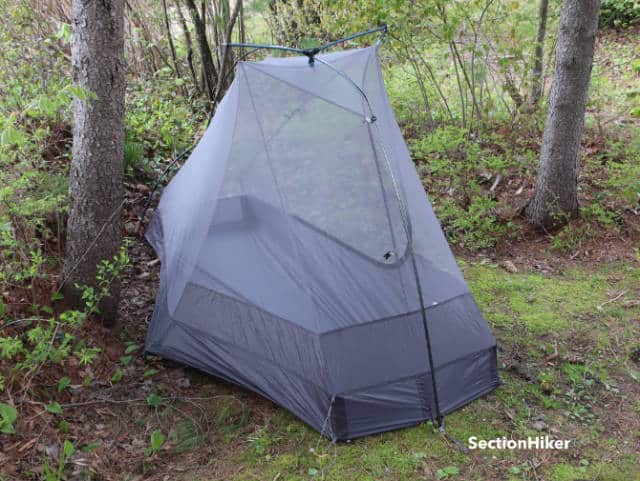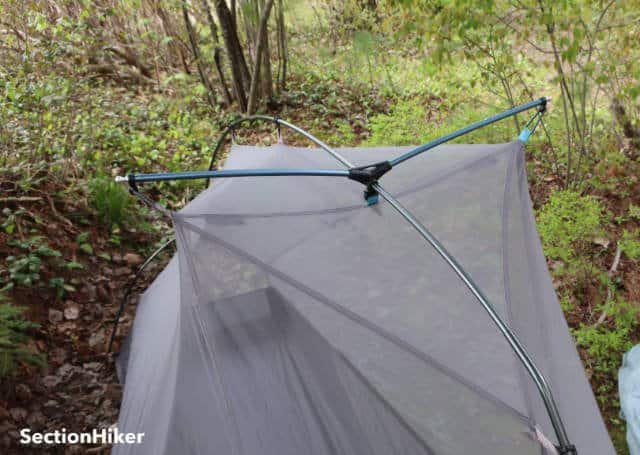The Sea to Summit Alto Tr1 is a one-person semi-freestanding double-wall tent that is lightweight and easy to pitch in tight spots. It has a single side door and vestibule that’s large enough to hold your pack without compromising access and is well ventilated to keep you cool and reduce internal condensation. One of the stand-out features of the tent is its interior volume in terms of headroom and spaciousness. The near-vertical walls and a five-sided inner tent make it possible to sit up fully, change your clothes, and store extra personal items inside that you want close to hand at night.
Specs at a Glance
- Best Use: Backpacking
- Sleeping Capacity: 1 Person
- Seasons: 3-season
- Design Type: Semi-freestanding
- Minimum Trail Weight: 2 lbs 1 oz
- Number of Doors: 1
- Number of Poles: 1
- Minimum number of stakes to pitch: 7
- Structural: Double-wall
- Actual Inner Tent Dimensions: 24″ x 78″, with 39″ of width in the side bump-out, peak height of 40″
- Materials: Fly and Floor – 15d Sil/PePU Ripstop Nylon 1200mm, 15D polyester mesh inner
- Footprint included: No
- For complete specs, visit the Sea to Summit product listing

The Sea to Summit Alto TR1 is a double-wall tent with a separate inner tent and rain fly. It is considered semi-freestanding because you need to stake out the head-end and side of the inner tent when setting it up. The tent has one multi-segment pole with a single hub and a cross pole, which Sea to Summit calls the “tension ridge” to help create near vertical walls in the inner tent.

Inner Tent
The inner tent has an abundance of mesh which provides great ventilation even on warm days. It has a single D-shaped door that makes it easy to get in and out of without having to crawl out under the front vestibule. The inner door has dual zippers, which makes it possible to open partway when you need to reach out to get items out of your pack. This is very handy in bug season when you want to keep the door opening as small as possible to keep bugs out of the inner tent.
The inner tent floor is five-sided with a triangular-shaped bump-out opposite the door. This makes the tent much more livable, giving you additional room for gear storage inside the tent as well as the headroom above it. I use this area to store the day clothes I change out of when I sleep, electronics, and personal items that I like to keep in the tent with me at night.

The inner tent has a definite “head” end and a foot end. The head end is the wider end with much more headroom, while the body of the tent slopes gently down toward the foot end. The inner tent has one mesh pocket for holding incidentals on the wall next to the door at the head-end of the tent. Additional snaps and gear loops on the ceiling and along the walls connect a headlamp light diffuser and accessory pockets using stuff sacks used to pack the tent components.

Tent Rainfly
The rainfly has a single vestibule door, split down the middle so you can store gear in one half without blocking door access. While the side door can be rolled back, ventilation is still quite good with the vestibule zipped closed, because the bottoms of the door are cut a bit short for added airflow.

One of the key features of the Alto Tr 1 is a top vent, shaped like an air scoop, that can be used to increase airflow between the inner tent and rain fly while venting the warm air and internal moisture that causes tent condensation to occur. However, it can only be opened or closed if you’re standing on the outside of the tent and not from within the inner tent, which is a curious design omission. I found that rain did not blow into the open vent, although that may be due more to the wind direction and the orientation of the tent when the heavens let loose. The vent is large enough that it’s a potential area of concern in the right conditions.

One thing worth noting is that the top vent is not screened, which makes it an irresistible point of entry for insects who want to hang out in between your inner tent and rainfly. I experienced this recently on a four-night trip in southern New Hampshire during the peak of black fly season. There were so many black flies bouncing around in between the inner tent and rainfly, that that it sounded like it was pouring rain outside my tent, even though it was sunny and dry As soon as the sun went down, they all flew out the vent and vanished. This was an extreme case, but you get the idea.

Packing
The Alto Tr1 comes with several modular stuff sacks to hold the tent poles, rainfly, and inner mesh tent. Each of these is a multi-use component that can be used as a lightbar or storage accessory inside the tent. They “fit” together when packed, but can also be carried loose and separately.
Tent Stakes
The Alto Tr1 also comes with a set of 9 lightweight tent stakes. Each weighs 6 grams and is configured like an MSR mini-groundhog with notches cut out of the side. I find them inconvenient to use with the thin cord-based guyline used on the Alto and recommend switching out to a needle stake with a hook at the top for a more secure anchor that won’t slip.
Comparable One Person Backpacking Tents
| Make / Model | Type | Weight |
|---|---|---|
| Sea to Summit Alto TR1 | Double Wall | 33 oz |
| Big Agnes Copper Spur HV UL 1 | Double Wall | 34 oz |
| NEMO Dragonfly 1 | Double Wall | 32 oz |
| Big Agnes Tiger Wall UL 1 | Double Wall | 30 oz |
| MSR Hubba NX 1 | Double Wall | 39 oz |
| REI Quarter Dome SL 1 | Double Wall | 31 oz |
Recommendation
The Sea to Summit Alto Tr1 is a very comfortable and spacious one-person tent. It stays reasonably cool in hot weather if you have to hang out to escape heavy insect pressure and it collects very little internal tent condensation, even in conditions when you’d expect it. If you find one-person tents cramped, I’d recommend giving the Alto TR1 a try. It’s easy to set up, well-made and fits easily in tight tent pitches. I think it’s exciting that Sea to Summit has put their design acumen into making lightweight but livable backpacking tents. If you like what you see here, but would rather have a two-person version, check out the Sea to Summit Alto Tr2.
Sea to Summit Alto TR1 Tent
Comfort
Ease of Setup
Weather Resistance
Durabilty
Weight
Packed Size
Disclosure: Sea to Summit provided a tent for this review.
SectionHiker is reader-supported. We only make money if you purchase a product through our affiliate links. Help us continue to test and write unsponsored and independent gear reviews, beginner FAQs, and free hiking guides. SectionHiker.com Backpacking Gear Reviews and FAQs
SectionHiker.com Backpacking Gear Reviews and FAQs 
Very nice. I’m getting tired of tiny tents. And I see on their site an option for a solid breathable inner will be available later this year. Just might be the ticket for those cold Oct./Nov. nights.
Thank you so much for reviewing the new Alto, the first I’ve seen. I’ve been an S2S fan for years. They make well designed gear that is top quality, with excellent customer service.
The Alto hits the mark on the first try. S2S must have done a lot of testing to get the details just right. The big win is the ventilation. Phil always takes care to point out condensation issues, so if he says it’s good on that point then it’s damn good in the field. A true 2 person tent is the only thing missing from my shelter quiver. The Alto looks to lead the pack of framed tents made of durable materials. Two doors means a lot more ventilation!
There’s only one door…
Hi I received my TR1 plus last week and have used it for two days opening and closing the vent from the inside is no problem if your young (76) and flexable. All I can say is Big Agnes Lightwave and Six Moons look out. I have them all, I cant wait for the WINTER to see how good a 3 + it is. I live in Wales in the UK. I have been waiting months for it.
David Lewis
Where in Wales? Beautiful country.
Decent design for fair weather.
Howsomever, I think my Tarptent Moment DW will go up twice as fast in good weather and 4X as fast in a rainstorm (when the inner tents are kept dry while setting up).
I used this tent recently on an 8 night trip in the sierra. I also really enjoyed this tent. One thing not mentioned in the above review that was a HUGE selling point for me was the star gazing mode. The design of this tent makes it really easy to roll up the rain fly on either side of the tent or both sides, while still making it easy to deploy in the event of inclement weather. I used this feature every night as I LOVE star gazing from inside the tent. I frequently had rain and had no trouble deploying the rainfly when needed.
It “kinda-sorta” has a Tarptent Single Rainbow shape and that’s good, especially for high winds.
I prefer my TT Moment DW solo tent and have used tin all seasons. For the possibility of heavy snow I have the optional Crossing Pole that I’ve shortened 6″ and run beneath the fly for even more support.
“ The inner tent has a five-sided floor that provides extra space for internal gear storage”
Is that big enough for a 50L backpack!
Kind of borderline. What’s wrong with storing it in the vestibule and just keeping the subset of stuff you want in the tent.
If you’ve ever had your pack chewed by rodents you will forever after be keeping it inside with you. Happened to me once but fortunately was the top pocket only. Seriously destroyed though.
I’ve never used a semi-freestanding tent before, is it possible to set this up on something like a cement pad or inside a shelter or is it really not useable unless you stake certain points out?
You need to stake out the corners.